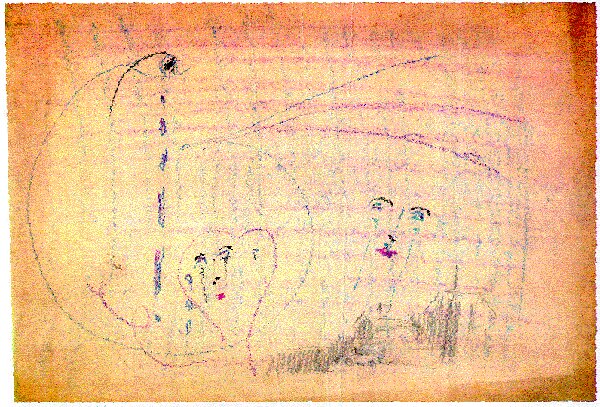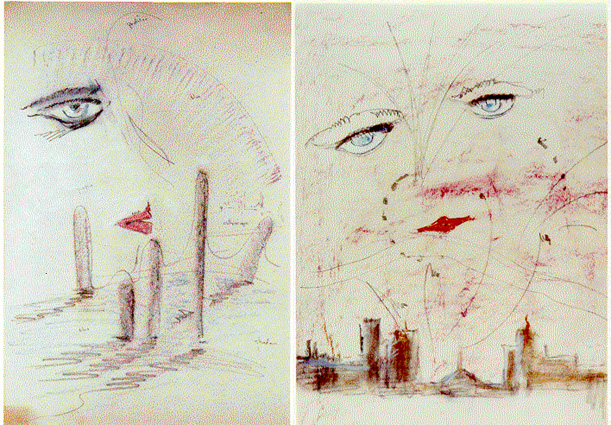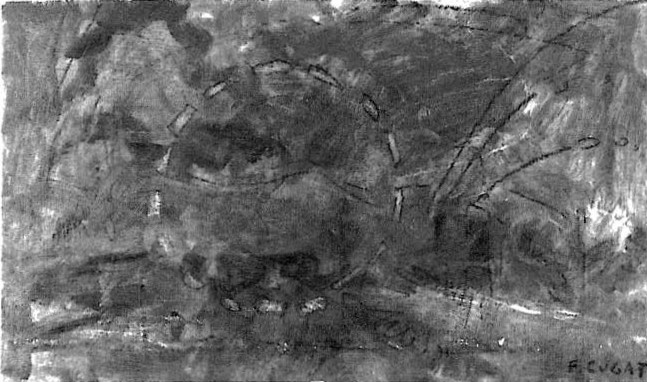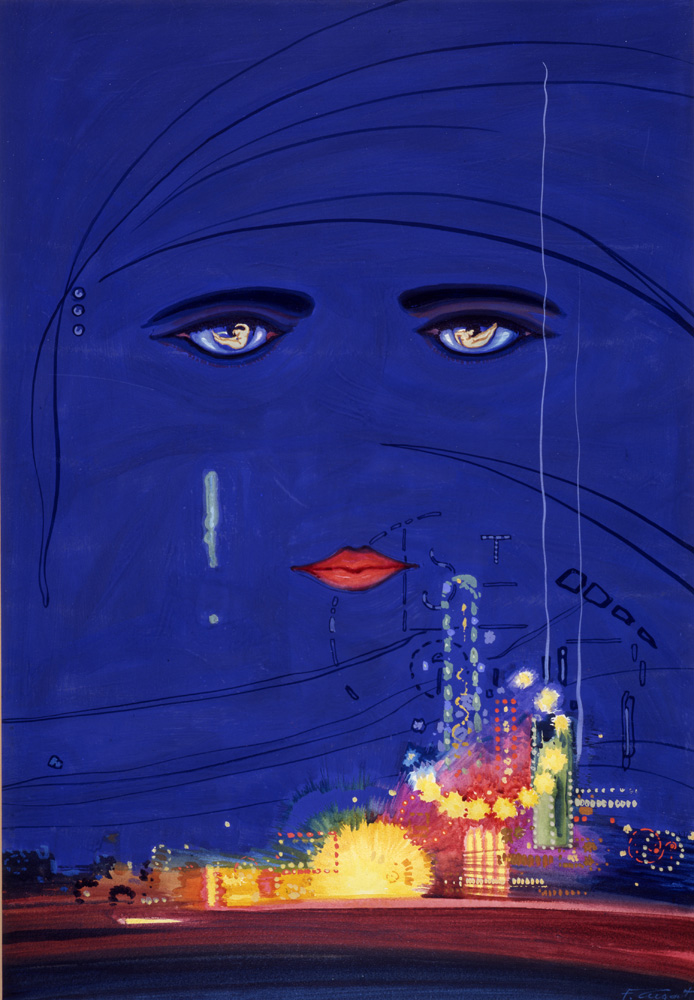
Celestial Eyes, From Metamorphosis to Masterpiece
By Charles Scribner III
Francis Cugat’s painting for F. Scott Fitzgerald’s The Great Gatsby is the most celebrated and widely disseminated jacket art in twentieth-century American literature, and perhaps of all time. After appearing on the first printing in 1925, it was revived more than a half-century later for the “Scribner Library” paperback edition in 1979[1]. More than a decade (and several million copies) later it may be seen in classrooms of virtually every high school and college throughout the country. Like the novel it embellishes, this Art Deco tour de force has firmly established itself as a classic. At the same time, it represents a most unusual — in my view, unique — form of “collaboration” between author and jacket artist. Under normal circumstances, the artist illustrates a scene or motif conceived by the author; he lifts, as it were, his image from a page of the book. In this instance, however, the artist’s image preceded the finished manuscript and Fitzgerald actually maintained that he had “written it into” his book[2]. But what precisely did he mean by this claim?
Cugat’s rendition is not illustrative, but symbolic, even iconic: the sad, hypnotic, heavily outlined eyes of a woman beam like headlights through a cobalt night sky. Their irises are transfigured into reclining female nudes. From one of the eyes streams a green luminescent tear; brightly rouged lips complete the sensual triangle. No nose or other discernible facial contours are introduced in this celestial visage; a few dark streaks across the sky (behind the title) suggest hairlines. Below, on earth, brightly colored carnival lights blaze before a metropolitan skyline.
It has been alleged that Fitzgerald’s symbolic billboard eyes of Dr. T. J. Eckleburg derived from Cugat’s jacket. Fitzgerald describes them as “blue and gigantic — their retinas are one yard high. They look out of no face, but, instead, from a pair of enormous yellow spectacles which pass over a non-existent nose.” If this hypothetical source is valid, then we are clearly not dealing here with a literal translation from graphic imagery into prose: there can be no mistaking of Cugat’s seductive visage for the grotesque, bespectacled eyes of the optician’s billboard. Yet each is, in its own way, both ethereal and mystical; each is explicitly abstracted from a face, in each case with the nose “edited out.” As we would expect from a writer of Fitzgerald’s imagination, he thoroughly transforms his visual sources, or background images, into his own creation: that is to say, one symbol evolves into another.
To those who still find the derivation troublesome, an alternative has recently been proposed for Fitzgerald’s acknowledged debt to Cugat: Nick Carraway’s image of Daisy as the “girl whose disembodied face floated along the dark cornices and blinding signs” of New York at night[3]. This citation at the close of chapter four appears to correspond perfectly with the final jacket. But, at the same time, it raises the question of how far we may reasonably seek interrelations between the jacket art and the text of Gatsby. In other words, what did Cugat know of the novel before he illuminated its jacket? And what did the novelist know of Cugat’s artwork before he completed his manuscript? Fortunately, Matthew J. Bruccoli’s recent discovery of Cugat’s preparatory studies and sketches for the design sheds new light on these questions as well as on the creative evolution of his iconographic masterpiece[4].
In the editor-author correspondence between Maxwell Perkins and Fitzgerald there are several references to the Gatsby jacket art. These comments are more intriguing than clarifying. The first occurs on 1April 1924: Perkins asks whether Fitzgerald has finally decided on a title for his new novel-in-progress so that Scribners might proceed to design a “wrap,” or jacket, in anticipation of its publication on Scribners’ fall list. (Fitzgerald’s ledger entry for that month begins “out of the woods at last and starting novel.”[5]) Six days later, Perkins writes that he does not like Fitzgerald’s proposed title, “Among the Ash Heaps and Millionaires,” although he likes the general idea it seeks to convey: “The weakness is in the words ‘Ash Heaps’ which do not seem to me to be a sufficiently definite and concrete expression of that part of the idea.” This reaction evidently prompts either a phone call or a meeting, and is followed by Fitzgerald’s confessional letter of circa April tenth (“A few words more relative to our conversation this afternoon…”) in which he explains that he has “every hope + plan of finishing my novel in June” but that it may take “10 times that long.” In any event, the new novel will be “a consciously artistic achievement + must depend on that as the 1st books did not.” Perkins replies on the sixteenth: “The only thing is, that if we had a title which was likely, but by no means sure to be the title, we could prepare a cover and a wrap and hold them in readiness for use. In that way, we would gain several weeks if we should find that we were to have the book this fall…”
On April fifteenth, Scott and Zelda decided to move to Europe. There is no further correspondence on the subject of a title or jacket art before they set sail in early May, The next written reference indicates a fait accompli, it appears in Fitzgerald’s long itemized letter sent from France some time in August. (Perkins acknowledged it on the twenty-seventh, and it took at least ten days for mail to travel by sea from the Villa Marie in St. Raphael to the Scribner offices in New York.) Item one: “The novel will be done next week. That doesn’t mean however that it’ll reach America before October 1st as Zelda and I are contemplating a careful revision after a week’s complete rest.” Item six: “For Christs sake don’t give anyone that jacket you’re saving for me. I’ve written it into the book.” This seemingly straightforward request has provoked much speculation among scholars: What did he mean by “don’t give anyone”? That Perkins should keep it secret? But that would nullify the very purpose in commissioning such art in advance, which was, then as now, to create promotional materials. The answer is simpler, and may be deduced from the context, or sequence, of the correspondence between editor and author.
In a letter of July fifteenth Perkins writes: “I suppose it will be here in a month or six weeks… In any case, your book could not now wisely be published this fall and the spring will be a good season with us because there is no other book of fiction that will have a large sale then…” From these remarks, Fitzgerald must have inferred (correctly) that since his new novel had been taken off the “rush” list for fall 1924 and would not be published for at least another nine months, there was no longer a current need to have jacket art for its advance promotion. Perhaps he feared that Cugat’s artwork might therefore be given to another book — or perhaps even to Scribner’s Magazine, for which it would have made a striking poster — rather than being held in abeyance for several more months. Perkins immediately puts this worry to rest in his response of September tenth: “There is certainly not the slightest risk of our giving that jacket to anyone in the world but you. I wish the manuscript of the book would come, and I don’t doubt it is something very like the best American novel.” Two things are clear: that Perkins had yet to read any of it, and that he would reserve for it the previously designed jacket art.
On October twenty-seventh, Fitzgerald writes that he is finally sending The Great Gatsby. (He offers as an alternate title “Gold-hatted Gatsby.”) He follows up a week or so later with a letter in which he says:
I have now decided to stick to the title I put on the book. Trimalchio in West Egg. The only other titles that seem to fit it are Trimalchio and On the Road to West Egg. I had two others Gold-hatted Gatsby and The High-bouncing Lover but they seemed too light.
On November fourteenth Perkins replies that none of his Scribner colleagues likes the “Trimalchio” title, and urges him to change it. Significantly, he adds: “But if you do not change, you will have to leave that note off the wrap. Its presence would injure it too much; — and good as the wrap always seemed, it now seems a masterpiece for this book,” Fitzgerald replies: “About the title. I’ll try my best but I don’t know what I can do. Maybe simply ‘Trimalchio’ or ‘Gatsby.’ In the former case I don’t see why the note shouldn’t go on the back.”
Fitzgerald’s typescript no longer exists, but the first set of the proofs is slugged “Trimalchio” at the top of each galley. We can only guess at the length and content of the note explaining Trimalchio’s source in Petronius’ Satyricon. That ancient Roman host of extravagantly decadent feasts did indeed offer a worthy prototype for Fitzgerald’s Gatsby, but would readers or booksellers have been able to pronounce it, much less spell it?
Fitzgerald was never satisfied with the title The Great Gatsby. Yet when the first copy of the book arrived he wrote to Perkins that he “thought the new jacket was great.” No doubt this concise compliment conveyed not only his approval of all its elements — illustration, flap copy, typography, and back ad — but also something of an inside joke. To the author it was “new” insofar as it incorporated for the first time an actual title, from which Fitzgerald quoted the adjective — perhaps with pointed irony, since he had earlier denigrated to Perkins its titular connection with Jay Gatsby: “‘The Great Gatsby’ is weak because there’s no emphasis even ironically on his greatness or lack of it. However, let it pass.”
Was the jacket “new” to Fitzgerald in other ways? The payment card in the Scribner art files confirms that Cugat designed only one jacket, for which he was paid one hundred dollars. If the original jacket painting that Perkins had promised to save for Fitzgerald had in fact been replaced by a new one, there would be some indication of it on the card, as well as the payment of an additional fee to the artist. It is inconceivable that Perkins would have allowed such a substitution without further comment to the author after his written promise and, equally important, after his declaring the original design “a masterpiece.” On the other hand, it is entirely conceivable that Fitzgerald had never seen Cugat’s final, finished artwork, the magnificent gouache painting today preserved in the Princeton University Library. Since there were at most a couple of weeks between the commission and Fitzgerald’s departure for France, it is likely that what he had seen — and “written into the book” — was one or more of Cugat’s preparatory sketches which were probably shown to him at Scribners for his comments before he set sail. We may turn to the sketches themselves in search of a plausible scenario.
In the first, Cugat has rendered in charcoal and pen-and-ink, washed with watercolor and gouache, a scene of a train passing through a deserted depot amidst a bleak, grey landscape with distant hills. Over the green building at the far left a faint, crude image of a face emerges from the dark sky. Cugat proceeded to enlarge this sketch, altering some of the architecture, transforming the central track into an undulating curve, and adding two significant elements that leave no doubt as to the connection between this watercolor and Fitzgerald’s novel-in-progress. The red coal cars are lettered “Long Island Railroad,” and over this ashen scene float, like so many balloons, a series of sad, feminine eyes and mouths — all without noses or other physiognomic features. Signed at the bottom right, this sheet clearly represents a modello, or demonstration piece, for the advance jacket and derives its conception from Fitzgerald’s originally proposed title, “Among the Ash Heaps and Millionaires.” Cugat probably based this scene on an oral briefing, either by the art director or by Perkins himself, that included Fitzgerald’s explanation to Perkins of the “valley of ashes” as it would eventually appear in chapter two: “About half way between West Egg and New York the motor road hastily joins the railroad and runs beside it for a quarter of a mile, so as to shrink away from a certain desolate area of land…” The fact that in Cugat’s sketch there is no indication of a billboard, much less the bespectacled eyes of Doctor Eckleburg, suggests that Fitzgerald had yet to conceive his optical symbol or, at least, had yet to share it with either his editor or the artist. We are left, then, with the enticing possibility that Fitzgerald’s arresting image was originally prompted by Cugat’s fantastic apparitions over the valley of ashes; in other words, that the author derived his inventive metamorphosis from a recurrent theme of Cugat’s trial jackets, which the artist himself was to reinterpret and transform through subsequent drafts.
Francis Cugat, preliminary sketch of a railroad scene, for the dust jacket of The Great Gatsby. Charcoal with pen-and-ink, watercolor, and gouache on paper. Matthew J. Bruccoli Collection.
Francis Cugat's second, enlarged version of the railroad scene, for the dust jacket of The Great Gatsby. Charcoal with pen-and-ink, watercolor, and gouache on paper. Matthew J. Bruccoli Collection.
The next stage, a quick pencil and crayon sketch, adapts structural elements (rooflines, poles, automobile) from the “valley of ashes” watercolors, but the geography is unclear. The emphasis has shifted upward to the celestial eyes — now weeping — with outlined eyebrows, rouged lips, and what appear to be asymmetrical nostrils completing the hovering visage. A second face, or perhaps an alternate pose, is sketched at the left and framed by a schematic heart that devolves into a sort of calligraphic kite’s tail. Above it, Cugat has drawn an enlarged version of the left eye, from which streams the broken, staccato trail of a tear, and which serves as the starting point for an expansive, purely abstract sweep of a circle breaking into three radiating lines — a variation on motifs already suggested by the cursive improvisations in the sky above the valley of ashes.
The focus on a single weeping eye links this rough draft with Cugat’s next, and innovative, conception of the jacket: the pencil and crayon drawing of the female countenance, now reduced to one eye with parted red lips and viewed in profile (as he has noted on the sheet). The schematic tear falls into Long Island Sound, with the New York skyline (labelled “cityscape”) in the background and five prominent pilings directly below. Cugat’s anatomical license is reminiscent of Egyptian hieroglyphics, if not Picasso. His invention — a beaconlike and beckoning eye of what Shakespeare called “the constant image” of the beloved — suggests an iconographic prefiguration of that “enchanted object” of Gatsby’s, the green light “of colossal significance” at the end of Daisy’s dock which had seemed as near to her “as the star to the moon.”
Francis Cugat's sketch of a face over a house, with details of a weeping eye, for the dust jacket of The Great Gatsby. Pencil and crayon on paper. Matthew J. Bruccoli Collection.
The next and penultimate version is rendered in pencil, crayon, charcoal, and gouache. Cugat here returns to his original image of a celestial visage seen straight on. Two full, bright blue eyes now hover over the expanded cityscape. Their hooded gaze alone expresses their sorrow; the trailing tear is integrated into a pattern of lines that punctuate the urban sky like so many flares or shooting stars.
Francis Cugat's sketch of a face over Long Island Sound, for the dust jacket of The Great Gatsby. Pencil and crayon on paper. Matthew J. Bruccoli Collection.
Francis Cugat’s sketch of a face over the New York skyline, for the dust jacket of The Great Gatsby. Pencil, crayon, charcoal, and gouache on paper, Matthew J. Bruccoli Collection.
Francis Cugat's study of a face, with geometric patterns, for the dust jacket of The Great Gatsby. Pencil on paper. Matthew J. Bruccoli Collection.
At some point between this sketch and the finished gouache painting, the decision was made to enliven the somber skyline of bricks and mortar by superimposing a dazzling carnival of lights, as though Manhattan had been relegated to a backdrop for riotous Coney Island. The remaining three working sketches (as distinct from modelli, or display models) offer glimpses into this final transmutation. The first is a graphic impromptu or fantasia. Through tentative, faint pencil outlines and quick broad strokes of colored wash, Cugat explores the dramatic juxtaposition of the heavenly serene faces, alternatively inclined, and the pyrotechnical explosion of swirling lights below. On a separate sheet, in pencil, he further refined the idealized physiognomy, enlarging the pupils and filling out the sensual lips; below, he improvised in dotted rhythms his basic geometric motifs: the circle, a steep parabola, and cascading arcs. Then, in a murky oil and crayon sketch, he experimented with the background from which his light-show was to burst forth. In the center we find again the schematic Ferris wheel which in the final gouache would be suggested by an incomplete series of yellow bursts.
Cugat’s carnival imagery is especially intriguing in view of Fitzgerald’s pervasive use of light motifs throughout his novel, specifically in metaphors for the latter-day Trimalchio, whose parties were illuminated by “enough colored lights to make a Christmas tree of Gatsby’s enormous garden.” Nick sees “the whole corner of the peninsula… blazing with light” from Gatsby’s bouse “lit from tower to cellar.” When he tells Gatsby that his place “looks like the World’s Fair,” Gatsby proposes that they “go to Coney Island.” Fitzgerald had already introduced this amusement-park symbolism in his short story “Absolution.” Written in 1923 as part of an early draft of the novel and published separately in 1924, it was originally intended to serve as the prologue illustrating an important facet of the Midwestern, Catholic youth of the central character who eventually developed into Jay Gatsby. At the conclusion of the story, a deranged priest encourages the guilt-ridden boy to go see an amusement park — “a thing like a fair only much more glittering” with “a big wheel made of lights turning in the air.” But “don’t get too close,” he cautions, “because if you do you’ll only feel the heat and the sweat and the life.” The evocation of this passage in Cugat’s jacket design suggests that someone had conveyed to the artist the symbolic light motif that defined Gatsby’s life[6].
Daisy’s face, says Nick, was “sad and lovely with bright things in it, bright eyes and a bright passionate mouth.” In Cugat’s final painting, her celestial eyes enclose reclining nudes and her streaming tear is green, like the light “that burns all night” at the end of her dock, reflected in the water of the Sound that separates her from Gatsby.
What Fitzgerald in fact drew directly from Cugat’s art and “wrote into” the novel must of course remain an open question. What is beyond doubt is that Perkins hit the mark when, having finally read the completed typescript, he declared the jacket “a masterpiece.” Yet Cugat’s name never appears again in the Scribner art file. He was not a regular contributor to Scribners. Who commissioned him? Nowhere is Cugat ever mentioned by either Fitzgerald or Perkins. The credit must almost certainly go to some anonymous angel in the Scribner art department.
On the art file card, there is a handwritten notation that Cugat’s gouache painting for Gatsby (mistakenly described as a watercolor: it does indeed look like one) was given to Fitzgerald on 2 April 1927. If so, he either gave it back to his publisher or left it behind when he returned home to Delaware, where he was struggling to make progress on the new novel that would become Tender is the Night[7].
Five days later, on April seventh, Perkins wrote: “I do not want to harass you about your book, which might be bad for it. But if we could by any possibility have the title, and some text, and enough of an idea to make an effective wrap, by the middle of April, we could get out a dummy. And even if all these things had to be changed, it would be worth doing this.”
We come full circle. April is not always the cruellest month. Three years earlier, Fitzgerald had planted with Perkins “enough of an idea to make an effective wrap,” and reaped a unique visual harvest.
Francis Cugat's final painting for the dust jacket of The Great Gatsby. Gouache on paper. The Graphic Arts Collection, Princeton University Library.
Notes
[1] Cugat’s cover was also used for the Collectors Reprints edition of The Great Gatsby (New York: Published by Collectors Reprints, Inc., by arrangement with Charles Scribner’s Sons, a division of Macmillan Inc., 1988).
[2] The Fitzgerald-Perkins correspondence is preserved in the Charles Scribner’s Sons Archives at the Princeton University Library. Most of the letters are published in Dear Scott/Dear Max, ed. J. Kuehl and J. R. Bryer (New York: Scribner’s. 1971). For a complete discussion of the composition and publication of the novel, see The Great Gatsby, Matthew J. Bruccoli, ed. (Critical Edition; London and New York: Cambridge University Press, 1991). For biographical background, sec Matthew J. Bruccoli, Some Sort of Epic Grandeur: The Life of F. Scott Fitzgerald (New York: Harcourt Brace Jovanovich, 1981).
[3] This observation was made to Professor Bruccoli by his student, Mary Jo Tate.
[4] Professor Bruccoli has very kindly provided the following account of the discovery: “In my 1990 F. Scott Fitzgerald seminar at the University of South Carolina, I discussed the thematic connections between The Great Gatsby and its original dust jacket, mentioning the mystery of Francis Cugat (or F. Coradal-Cugat). Little is known about the artist responsible for the most eloquent jacket in American literary history: he was born in Spain in 1893 and raised in Cuba; he was brother of orchestra leader Xavier Cugat; he worked in Hollywood as a designer for Douglas Fairbanks; he had a one- man New York show in 1942; he died on 13 July 1981. No other Cugat book jackets have been identified. “A student in my seminar, Martha Alston, mentioned the mystery to her visiting aunt and uncle, Evelyn and Harvey Kilby; they traced a collection of Cugat’s work to the Wilmington, Delaware, artist and restorer Roy Blankenship, who had acquired them from a Connecticut gallery. Mr. Blankenship permitted me to purchase the eight pieces I recognized as preceding the Gatsby jacket.”
[5] F. Scott Fitzgerald's Ledger, Matthew J. Bruccoli, ed. (Washington: Bruccoli Clark/ NCR Microcard Editions, 1973).
[6] For an excellent analysis of light imagery and religious metaphors in Fitzgerald's work, see Joan M. Allen, Candles and Carnival Lights: The Catholic Sensibility of F. Scott Fitzgerald (New York: New York University Press, 1978), especially pp. 93-116.
[7] Decades later, my cousin George Schicffelin discovered it at Scribners in a trash can of publishing “dead matter” and preserved it for posterity. Eventually I inherited the painting, enjoyed it at home for several years, then donated it to the Princeton University Libraries for the Graphic Arts Collection.
Published in Princeton Univercity Library Chronicle magazine (VOLUME LIII • NUMBER 2 • WINTER 1992).









